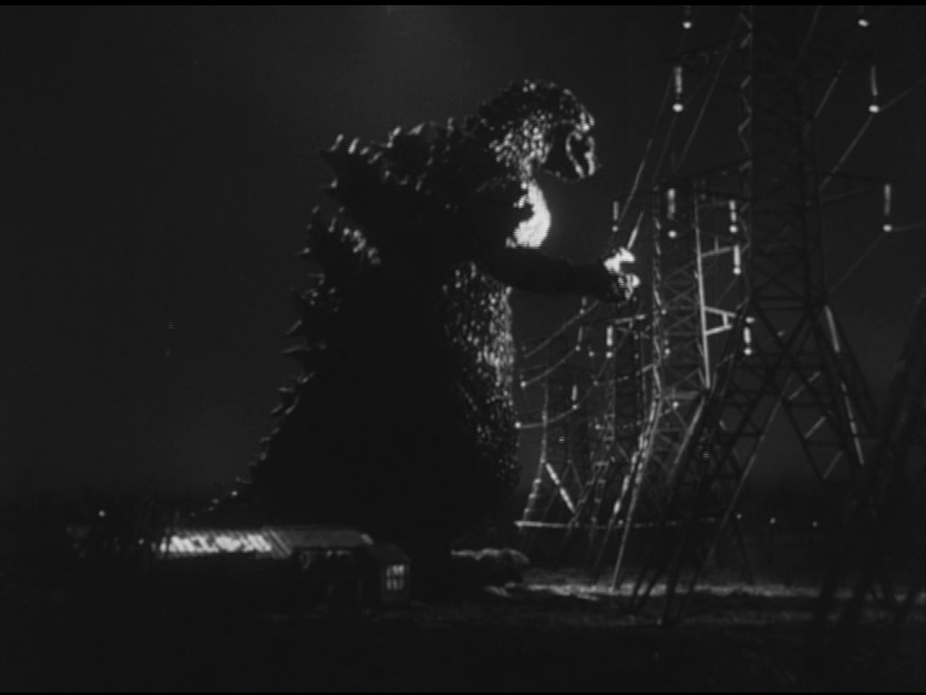The emptiness that is the product of American bombs rumbles, and from within the cracks of imperialisms, both Western and Eastern, emerges an uncontrollable monster. Technocrats, bureaucrats and capitalists, the rulers and petty “Eichmen” who constitute the triumvirate of the military-industrial-scientific complex – politicians all – scramble to come up with “solutions” to the “problem.”
But the monster, bathed in pathos, stumbles on, awkwardly stepping on buildings and people, emitting grey breaths that metamorphose into fire on bodily contact.
The people cry out in bewilderment, fear and anger at the monster; only a select few understand the relationship between the original bombs and the appearance of this antediluvian force. These few shake their heads, but cynically search for new means of mass destruction, hiding their knowledge – and readily acknowledged partial culpability – from the distraught public.
Eventually a new death-force is unleashed by a buccaneer-type scientist sporting an eye patch. This weapon is the epitome of the “atmoterrorist” warfare that, as German philosopher Peter Sloterdijk argues in Terror from the Air (2009), is the hallmark of twentieth century technological progress.
In an oddly arresting, melancholic sequence, the monster is strafed back towards the ocean, and the ocean, as one of the life-media of the monster, is transformed into a death-space.
The ocean is left black and rippled, a scaly, reptilian surface awaiting the next irruption of monstrosity.

Taking Jorge Louis Borges’ provocation in the essay “Kafka and His Precursors” that works create both their antecedents and descendants with some large grains of salt, Ishirô Honda’s film of 1954, Godzilla (originally Gojira), appears to be, perhaps, the most accurate commentary on the current situation in Syria.
There is no need to watch, therefore, the hawks - and hawks in doves’ clothing - of Fox News and CNN; we just need to re-watch Godzilla to understand what is actually a fairly simple series of geopolitical and geo-ethnic events despite their frequent mystification under Western allegations of complexity.
A power vacuum is created by what could at best be described as American-Western hubris. This is then filled by other fields of competitive force. The West responds with either a cynicism or (being generous) stupidity that will, undoubtedly, strengthen the body of resistance: engorging ISIS’ repressive stimuli and enhancing its appeal to the disenfranchised, who are produced through the inaccuracy of drone and manned air strikes.

ISIS is, like Godzilla, then, a kind of “accident” of Western “humanitarianism” and interventionism. And the accident, as Aristotle argued, in fact reveals the substance.
Of course, there are some fundamental differences between the romantically alienated beast Godzilla, and the politically savvy and imperialistic ISIS, and if, to draw on another fabled cinematic beast, King Kong (1933) embodies a kind of modern, pre-Holocaust US vitality and naivete, then Godzilla represents a post-Hiroshima Japanese humility.
In any case, there are, despite the protestations of nationalists and rulers to the contrary, no such things as monsters. Rulers effectively allege monsters to justify the nakedness of their own power, whereas nationalists generally don’t know any better. Such “holy wars” act, Sloterdjik argues in Critique of Cynical Reason (1987), as a kind of mass-psychological mechanism for resolving inherent ideological and affective tensions:
Since 1096, the holy war functions in Western civilizations as a safety valve. Under the pressure of their own inner contradictions and madnesses, people have since then sought external, diabolical enemies and have waged the holiest of wars against them. […] Jews, heretics, witches, Antichrists, and Reds are all victims of a primarily inner formation of fronts that emerge during highly schizoid periods of pressure, when the irrationality of the whole society seeks an outlet for contradictory ethics. (237)
If, as Karl Marx famously suggested regarding Napoleon III, history repeats itself, first as tragedy, then as farce, then where does the current Western bomb-mania – pyrobophilia – sit in this series of killings, this “serial-killing”? After a century and a half of grim trench warfare and the grinding of bodies through industrial death-apparatuses – after the Franco-Prussian war, Verdun and Auschwitz, and also after Hiroshima, Vietnam and Iraq – this question seems particularly pertinent. What follows “farce” in the current historiographical series?

We should remember that there are 30 Godzilla movies (including sequels and remakes), several video games and television series, with more slated. Perhaps, to draw on Sloterdijk’s Critique once again,
We must first flee into reality out of the systematised paranoia of our everyday world. (228)

